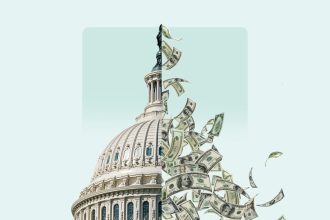On the eve of Tuesday’s presidential debate between Vice President Kamala Harris and former President Donald Trump, we are taking a look at the positions both candidates have staked out on economic issues that are most likely to impact your wallet
The Economy and Your Wallet
Investment banking firms Goldman Sachs and Nomura issued reports last week that determined a Harris-Walz victory that puts control of Congress in the hands of Democrats would boost the economy and enhance the financial well-being of most Americans.
Goldman Sachs issued a note Wednesday predicting that growth and employment under a Harris administration would continue to rise. In contrast, another Trump administration would bring a decline in economic output and reduced job growth resulting from increased tariffs and restrictive immigration policies.
“We estimate that if Trump wins in a sweep or with divided government, the hit to growth from tariffs and tighter immigration policy would outweigh the positive fiscal impulse,” the Goldman Sach note stated.
“If Democrats sweep, new spending and expanded middle-income tax credits would slightly more than offset lower investment due to higher corporate tax rates,” contended Goldman Sachs.
Goldman Sachs predicts that job growth after the election will increase in direct proportion to the extent of a Democratic victory in November. Specifically, Goldman says 10,000 more jobs would be added monthly under Harris as opposed to Trump.
In addition, Goldman sees inflation rising under Trump by as much as .4 percent.
Nomura’s report took a global view of the impact of Trump’s plans and determined they would increase inflation by .75 percent next year. As a result, the investment banking firm forecasts that Trump’s tax plan and high tariffs will inhibit interest rate cuts by the Federal Reserve Bank.
The differences in the Harris vs. Trump forecasts are primarily the results of the candidates’ policy proposals regarding taxes and tariffs.
Taxes and Your Wallet
Harris and Trump have starkly different plans for taxes.
Trump has advocated cutting taxes on the wealthy and corporations. That, he contends, will trickle down to middle and lower-class households.
Harris, on the other hand, favors raising taxes on the most wealthy individuals and corporations to pay for programs aimed at helping middle and lower-class households.
However, there is some area of agreement. Both have advocated eliminating taxes on tips.
Calculations from two independent research organizations have found that middle-class households would gain net income under both candidates’ tax plans. However, gains from Trump’s tax intuition would turn to losses when his tariff plans are factored in. More on tariffs below.
A household with $80,000 annual income would gain $1,700 after taxes under Trump, according to the Penn Wharton Budget Model. The model shows that after-tax income for the same household would increase by $2,2000 under Harris’s tax plan.
Those in the upper 0.1 percent of income ($14 million annually) would gain $377,000 under Trump’s proposals while they would lose $167,000 under Harris’s plans.
Tariffs and Your Wallet
Trump and Harris also have different approaches to tariffs.
Used as a means of increasing prices on imported goods, tariffs are intended to make the prices of domestic and foreign products roughly equal.
While a tax plan has to be passed by Congress, tariffs can be enacted by a president at will.
Trump advocates a blanket 10 to 20 percent tariff on all foreign goods with a 60 percent tariff on China imports.
Harris maintains that Trump’s tariff strategy is too wide-ranging and will result in higher prices for consumers. In her acceptance speech at the Democratic National Convention, she characterized the former president’s plan as “a Trump tax”.
Analysis by the Peterson Institute for International Economics (PIIE) seems to bear Harris out.
If Trump adds tariff proposals to his tax strategy, Trump’s plans will reduce the after-tax income of middle-class households, according to PIIE. Remember that $80,000 household that would take home $1,700 more under Trump’s tax plan? They would end up losing (instead of gaining) $1,700 a year if both tax and tariff plans were implemented.
Other economists have weighed in on Trump’s tariff and tax programs.
“But even just a step in that direction is problematic,” Mark Zandi, Moody Analytics’ chief economist told CNN. “It’s a very bad idea. If there is anything that most economists can agree on, it’s that tariffs are bad.”
J.P. Morgan’s David Kelly, also speaking to CNN, said Trump’s tariff idea is “one of those magical economic proposals that can actually cause inflation and put you into a recession – at the same time,”
Tariffs can disrupt supply chains and lead to retaliation from trading partners.
“It’s a two-year-old’s mentality: You punch someone in the nose and expect them not to punch you back,” Kelly said.
The National Debt and Your Wallet
The fiscal plans of both candidates will increase the national debt according to the Penn Wharton Budget Model. However, Trump’s proposals will add almost five times as much as Harris’.
Trump’s plans would add $5.8 trillion to the debt over 10 years while Harris’ plans would increase the debt $1.2 trillion over the same time.
The candidates differ on how to cover the costs of their programs. Harris favors increasing income taxes on individuals earning over $400,000 a year. She also advocates increasing corporate taxes from 21 percent to 28 percent.
On the other hand, Trump thinks tariffs will cover his deficits.
Family Living Expenses and Your Wallet
Both candidates have said they would support legislation to make child care more affordable. In fact, both candidates have some history of trying to lower childcare costs.
Trump failed to get congressional backing for increased childcare spending during his presidency. However, he did succeed in doubling the child tax credit and getting paid leave for federal employees.
Harris worked as vice president to push for national family leave and universal pre-kindergarten.
Helping families with the cost of child care is one thing, but the devil is in the details. One candidate, Trump, is lacking in specifics.
Twice Trump was asked about how he would help with childcare expenses during his debate with President Joe Biden. Twice he sidestepped the issue. He was asked again how he would help families struggling with childcare costs during a Thursday session at the Economic Club of New York. Again, he provided no specifics.
“As much as child care is talked about as being expensive, it’s, relatively speaking, not very expensive compared to the kind of numbers we’ll be taking in,” Mr. Trump said. Again he was speculating that blanket tariffs would cover costs.
Trump’s vice presidential pick, Senator J. D. Vance has not helped things. He told a Mesa, AZ gathering on Wednesday that parents should seek help from family members.
“Maybe Grandma and Grandpa want to help out a little bit more,” Vance said when asked what could be done to help families with childcare costs.
Harris, on the other hand, has been more forthcoming. She unveiled her economic plan last month which includes raising the child tax credit from the current $2,000 to $3,600. In addition, she proposes giving families of newborns $6,000 to help with care in the first year.
Governor Tim Walz, as Harris’ running mate, lends support to her advocacy of paid family and medical leave. He signed such a provision into Minnesota law in 2023.
Social Security
Social Security has been off-limits for presidential candidates for generations. This year is no different. Trump has pledged not to cut social security. By contrast, Harris has vowed not only to protect but to expand social security
“I will never do anything that will jeopardize or hurt Social Security or Medicare,” Trump said in a March interview with Breitbart News.
Although Trump does not seem to intend to “hurt social security” – his tax plan might do just that Michael Ryan, founder of michaelryanmoney.com, told Newsweek.
“His plan to eliminate taxes on Social Security benefits might sound appealing,” Ryan said. “But let’s be real. It will likely just worsen the system’s long-term funding challenges.”
As a senator, Harris co-sponsored legislation that would increase revenue to Social Security by extending the income limits for payroll taxes to income over $250,000 a year. She has also proposed changing the annual Cost of Living Adjustment (COLA) to determine increases in social security benefits. Instead of using the CPI-W (Consumer Price Index for Urban Wage Earners), Harris wants to switch to using the CPI-E (Consumer Price Index -Elderly) to figure COLA. The CPI-E is a more accurate measure of prices for seniors. It is usually slightly higher than the CPI-W.
Read More:
- Caffeine May Impact Gut Health Unexpected Discovery Finds
- Fighting Rising Prescription Drug Prices
Read the full article here














